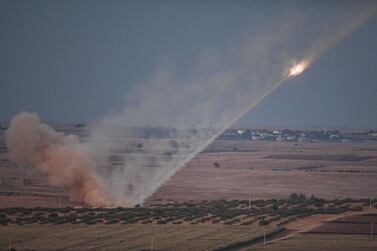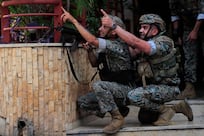In Syria’s north-east, a power vacuum is rapidly being filled – and for the first time in many years, it is the region’s own states, from Turkey to Syria and Iran, who are leading the charge to fill it.
Since the 1990 Gulf War, the US has primarily guaranteed the Middle East’s security and few of its conflicts escaped American influence or interference. But as consistent as this security architecture was, back in America it became politically difficult to defend as time went on. Now, in Syria’s north-east, war weariness has propelled a US pullout and a geopolitical vacuum. This space is rapidly being filled by the region’s own powers – Turkey, Iran and Syria – with the Russians carrying out a delicate dance between them all.
Turkey is racing against the clock, both from a security and economic point of view. First, it is attempting to get ahead of Syrian, Russian and Iranian forces that can block its advances. That is a race fraught with miscalculation. As troops move rapidly into positions, firefights and skirmishes could ensue. Turkey has stronger ties with Russia so there is less risk of Russia and Turkey directly clashing – and if they do, they will de-escalate quickly.
Rather, it is a Syrian-Turkish clash that is most dangerous. The Syrian Democratic Forces, desperately seeking allies, are bringing in Syrian troops to bolster against Turkey. As it does so, the SDF will be fighting back against the Turkish army. Syrian regime troops could be drawn into such battles, especially as Damascus seeks to gain as much territory in the north-east as possible. That will create a crisis between Syria and Turkey on a new front and force Moscow to mediate yet again between them. But Russia does not have the same leverage with the SDF, now increasingly coming under Damascus’s umbrella, as it does with the Assad regime. The SDF can play spoiler to such de-escalation.
Turkey must also outrace sanctions before they begin to bite. President Recep Tayyip Erdogan is relying on Donald Trump to mitigate sanctions but the US president is already backtracking on whatever implicit promises he made to Mr Erdogan in the face of bipartisan congressional outrage. American sanctions are coming, and European ones will follow too, disrupting Turkey's economy just as it begins to stabilise from last year's currency crisis. The scope and scale of those sanctions remain to be seen and they will be driven by the political optics of Turkey's military operation: the more the operation appears to be a human rights violation, the stronger the sanctions. Once the sanctions start to have a strong impact, it will be very hard for Turkey to continue its military offensive.
Moscow can claim that it outlasted the Americans in Syria and is a more reliable ally to the region’s actors than the US. This will be a diplomatic boon for Russia as it rebuilds its influence in the Middle East but from a purely practical standpoint, the gains in the north-east just nudge Russian influence closer to the status quo pre-2011 rather than to a new, heightened power. Before 2011, Syria, fully under Bashar Al Assad’s control, was a reliable, stable and relatively developed ally. Now, while Russia has proven it will go far to protect its close allies, it is doing so on behalf of a Syria that is severely depopulated, economically undermined and partially still under rebel control. Russia increasingly is footing the bill for the conflict – and with the Americans leaving the north-east, Moscow cannot even hope that the US will aid its former SDF allies in reconstructing Syria on a regional level.
Bigger questions are now emerging. The US has proven that its support for strategic proxies has a limited shelf life. Other allies in the region will take note and attempt to reduce their dependence on the US for their security. There is a difference with the SDF, of course – it was a faction, not a country. But that difference will not comfort those worried that Mr Trump is continuing his predecessor Barack Obama’s retrenchment from the region.
For America’s adversaries such as Iran, the experience will show that sometimes American domestic politics can triumph over strategic goals. Mr Trump’s political base has long wanted disengagement from Syria because of its aversion to America’s decades of military experience in the Middle East. But if the US is willing to pull back from Syria, what might convince it to scale down support for other allies elsewhere? Tehran will be thinking hard about what levers to pull to change the US domestic political narrative against Iran and gain an upper hand against the US sanctions strategy. America’s allies, meanwhile, will be racing to stop it doing so – and increasingly finding that, after 18 years of war in the Middle East, they have fewer allies in Washington willing to listen.
Ryan Bohl is a Middle East and North Africa analyst at geopolitical risk consultancy Stratfor, focused on regional strategy, security, politics and social contracts






